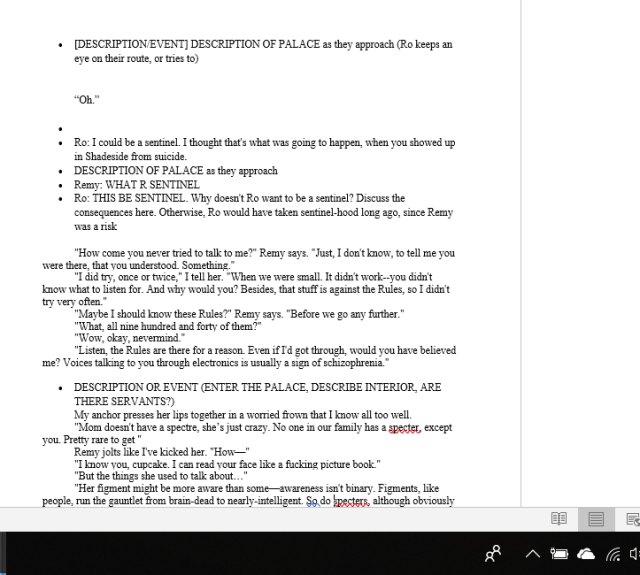I wrote this post recently when discussing with @Essa_Hansen how totally different our approaches are (I find this kind of thing endlessly fascinating.) There are a lot of different approaches to drafting, or writing as a whole; this is mine. Not better or worse than anyone else’s, but simply what works for me.
Pre-drafting
I don’t have a broader novel-level outline, and write out of order, so what is included below is the process of drafting a new chapter (or in this specific case, overhauling a chapter from scratch.)
Stage 1
Fill out that blank page. Notes on one side, bullet points for chapter on the other. The notes are thoughts or ideas that help me pin down what I need to happen, and the chapter bullet points are how those events can fit together in a logical way.
Because I do not have a set outline that I am working from, only rough “crucial pillar” scenes that I am building towards, I do a LOT of these drafts and end up retyping bullet points until it all makes sense. More or less.
The stage is complete when I have a “dialogue skeleton” to build on. The chapter more closely resembles a theatre script at this point, with almost 0 narrative. Also note how the dialogue isn’t real dialogue, it’s more a summary of what’s being said; it’s pretty comedic if you actually read it straight. I do that so I have clarity for myself on what needs to be conveyed, and only play with how it is conveyed in the revision stages.

Stage 2
Start filling out the bits that I know. I begin by fleshing out the dialogue bullets into actual dialogue that doesn’t read like a parody, then couching the lines in narrative, action beats, preliminary internal thoughts (often very tell-y, not much show).
The chapter starts to have a crude shape emerging, and moves comfortably into the range of being a narrative rather than a script. I typically do two drafts at this stage.
DESCRIPTIONS, TRANSITIONS, and other such aspects are missing. Those will be filled in later; I find descriptions hard.
Nota bene: In subsequent edits, Siduri/Udama are merged into the character of Ana.


Stage 3
Okay! The story looks like, well, a story now. I do 1-2 revision passes just for descriptions, then another 1-2 passes just for transitions. Descriptions are very hard for me; I have to think a lot about how to convey details without boring the reader or slowing my pacing. Transitions (moving between locations or scenes) are similarly difficult, especially in a single POV book where I can’t jump to a different perspective to avoid transitioning.
Sections of text are often moved around at this point, a result of me trying to control for flow. Information needs to be given naturally, and sometimes the dialogue is adjusted for that as well.
In the SS below, the section in red has been pasted into a different portion of the chapter, and the actions/events have been revised accordingly. Pacing is everything, after all. Although I’m sure there’s a better way to do it than this, I tend to stick to trial and error. Going with the feel of what’s right.

Stage 4
Things are wrapping up, where I’ve done the horrible hard things. This is my favorite bit, where the text is transformed from functional to fun through fine-tuning and small-scale tweaking. I’ve built my Frankenstein monster, now he needs some life.
Several passes for emotional nuance and interiority, plus show-not-tell, repetitive word elimination, and flow. Can anything be trimmed? Does anything need padding? Are any sections abrupt, any reactions too strong or repeated too often? Etc.
I read the chapter start-to-finish several times, then usually back-track and re-read the previous chapters if they’re in place (not always, since I write out of order) to see how it “feels” in situ. If in doubt, re-read and revise. Twice.

…and the chapter is complete, for now.
Feedback & beyond
Once the entire novel has undergone that process across every chapter, and then the whole MS revised 3 or 4 more times, I start sending out to my critique partners for feedback. But that’s an entirely different set of hoops to jump through.

Fascinating! Thanks for sharing 🙂
LikeLike
This was so helpful and fascinating! Thank you for sharing.
LikeLike